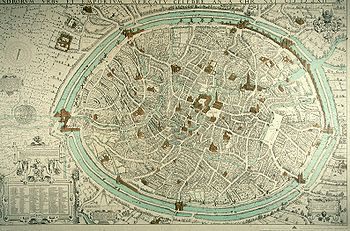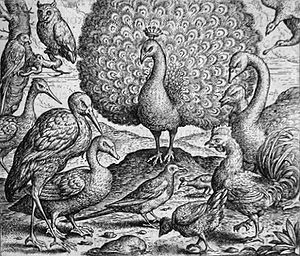
Marcus Gheeraerts the Elder
Encyclopedia


Painting
Painting is the practice of applying paint, pigment, color or other medium to a surface . The application of the medium is commonly applied to the base with a brush but other objects can be used. In art, the term painting describes both the act and the result of the action. However, painting is...
associated with the English court of the mid-16th Century
Artists of the Tudor court
The artists of the Tudor court are the painters and limners engaged by the monarchs of England's Tudor dynasty and their courtiers between 1485 and 1603, from the reign of Henry VII to the death of Elizabeth I....
and mainly remembered as the illustrator of the 1567 edition of Aesop's Fables
Aesop's Fables
Aesop's Fables or the Aesopica are a collection of fables credited to Aesop, a slave and story-teller believed to have lived in ancient Greece between 620 and 560 BCE. The fables remain a popular choice for moral education of children today...
.
Biography
Born in BrugesBruges
Bruges is the capital and largest city of the province of West Flanders in the Flemish Region of Belgium. It is located in the northwest of the country....
, Flanders
Flanders
Flanders is the community of the Flemings but also one of the institutions in Belgium, and a geographical region located in parts of present-day Belgium, France and the Netherlands. "Flanders" can also refer to the northern part of Belgium that contains Brussels, Bruges, Ghent and Antwerp...
, Gheeraerts fled to England
England
England is a country that is part of the United Kingdom. It shares land borders with Scotland to the north and Wales to the west; the Irish Sea is to the north west, the Celtic Sea to the south west, with the North Sea to the east and the English Channel to the south separating it from continental...
in 1568 with his son, Marcus Gheeraerts the Younger
Marcus Gheeraerts the Younger
Marcus Gheeraerts was an artist of the Tudor court, described as "the most important artist of quality to work in England in large-scale between Eworth and Van Dyck" He was brought to England as a child by his father Marcus Gheeraerts the Elder, also a painter...
(1562–1635), due to the Alvan religious persecutions. There he married his second wife, Sussanah de Critz, a close relative of Queen Elizabeth I's
Elizabeth I of England
Elizabeth I was queen regnant of England and Ireland from 17 November 1558 until her death. Sometimes called The Virgin Queen, Gloriana, or Good Queen Bess, Elizabeth was the fifth and last monarch of the Tudor dynasty...
serjeant-painter, John de Critz
John de Critz
John de Critz or John Decritz was one of a number of painters of Flemish and Dutch origin active at the English royal court during the reigns of James I of England and Charles I of England...
. He was in London
London
London is the capital city of :England and the :United Kingdom, the largest metropolitan area in the United Kingdom, and the largest urban zone in the European Union by most measures. Located on the River Thames, London has been a major settlement for two millennia, its history going back to its...
for at least 9 years but may have returned to Flanders around 1577 to continue his career in Antwerp. However, Gheeraerts retained links with England: he had his son enrolled in the painters guild and one of his daughters, Sarah, married the famous French-born English limner
Limner
A limner is an illuminator of manuscripts, or more generally, a painter of ornamental decoration. One of the earliest mentions of a limner's work is found in the book Methods and Materials of Painting by Charles Lock Eastlake .-Scotland:...
Isaac Oliver
Isaac Oliver
Isaac Oliver was a French-born English portrait miniature painter.-Life and work:Born in Rouen, he moved to London in 1568 with his Huguenot parents Peter and Epiphany Oliver to escape the Wars of Religion in France...
.
Gheeraerts is most noteworthy as a printmaker. He was a keen innovator and experimented with etching
Etching
Etching is the process of using strong acid or mordant to cut into the unprotected parts of a metal surface to create a design in intaglio in the metal...
at a time when woodcut
Woodcut
Woodcut—occasionally known as xylography—is a relief printing artistic technique in printmaking in which an image is carved into the surface of a block of wood, with the printing parts remaining level with the surface while the non-printing parts are removed, typically with gouges...
and engraving
Engraving
Engraving is the practice of incising a design on to a hard, usually flat surface, by cutting grooves into it. The result may be a decorated object in itself, as when silver, gold, steel, or glass are engraved, or may provide an intaglio printing plate, of copper or another metal, for printing...
were dominant techniques. For example, his 1562 birds-eye view of the town of Bruges
Bruges
Bruges is the capital and largest city of the province of West Flanders in the Flemish Region of Belgium. It is located in the northwest of the country....
was etched on no fewer than 10 different plates, and the resulting map measures 1m x 1.8m.
Gheeraerts' style resembles that of Pieter Bruegel the Elder. In his own day, Gheeraerts was particularly famous as a draughtsman of birds and animals, and since the Protestant Reformation
Protestant Reformation
The Protestant Reformation was a 16th-century split within Western Christianity initiated by Martin Luther, John Calvin and other early Protestants. The efforts of the self-described "reformers", who objected to the doctrines, rituals and ecclesiastical structure of the Roman Catholic Church, led...
had caused a still-stand in the church art market, he showcased his talent in the fable
Fable
A fable is a succinct fictional story, in prose or verse, that features animals, mythical creatures, plants, inanimate objects or forces of nature which are anthropomorphized , and that illustrates a moral lesson , which may at the end be expressed explicitly in a pithy maxim.A fable differs from...
book De warachtighe fabulen der dieren from 1567. He etched the title page and 107 fable illustrations and had his friend, Edewaerd de Dene, write the book's fables in Flemish
Dutch language
Dutch is a West Germanic language and the native language of the majority of the population of the Netherlands, Belgium, and Suriname, the three member states of the Dutch Language Union. Most speakers live in the European Union, where it is a first language for about 23 million and a second...
verse. Gheeraerts based most of his motifs on woodcut
Woodcut
Woodcut—occasionally known as xylography—is a relief printing artistic technique in printmaking in which an image is carved into the surface of a block of wood, with the printing parts remaining level with the surface while the non-printing parts are removed, typically with gouges...
s by Virgil Solis
Virgil Solis
Virgil Solis or Virgilius Solis , a member of a prolific family of artists, was a German draughtsman and printmaker in engraving, etching and woodcut who worked in Nuremberg. His prints were sold separately or formed the illustrations of books; many prints signed by him are probably by assistants...
and Bernard Salomon but gave his subjects greater naturalism. Gheeraerts added another 18 illustrations and a new title page for a French version of the Fabulen that was published in 1578 under the title Esbatement moral des animaux. A Latin version, Mythologia ethica, was published in the following year with a title page likely based on a drawing by Gheeraerts. The copper plates were used in books well into the 18th Century and the fable series was copied by artists all over Europe. Gheeraerts also etched a second series of 65 illustrations for the fable book Apologi creaturarum, which was published in Antwerp in 1584. However, the etchings were smaller than those of the first series and never achieved the same popularity.
Less is known about Gheeraerts' color portraits or paintings as he never signed his work, and what does exist is identifiable only from stylistic considerations – a certain "fuzziness" and an attempt to imitate Flemish artists of the past such as Jan Van Eyck
Jan van Eyck
Jan van Eyck was a Flemish painter active in Bruges and considered one of the best Northern European painters of the 15th century....
. Karel van Mander wrote in his Schilderboeck from 1604 that Gheeraerts was a good landscape painter, who "often had the habit of including a squatting, urinating woman on a bridge or elsewhere." A similar detail is seen in one of his fable illustrations.

